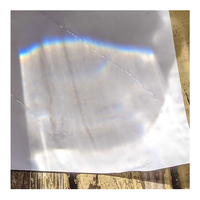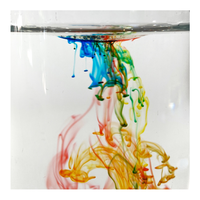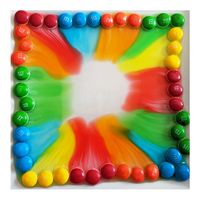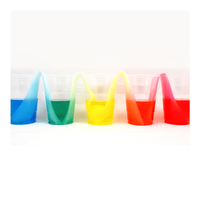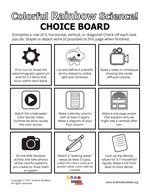7 Rainbow Experiments for Science Class
Making learning fun is sometimes half the battle! With the right activities, educators can ensure learning about science and engineering involves hands-on fun for students of all ages. Build in some colorful science exploration with STEM experiments on a rainbow theme!
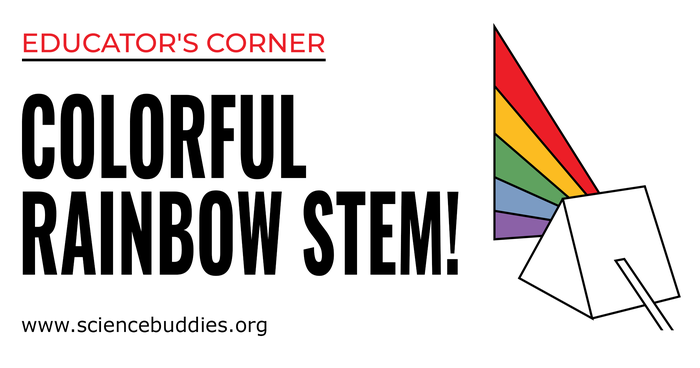
Rainbow STEM!
The science of visible light and the physics involved in what we see as a rainbow can lead to exciting hands-on science investigations and experiments. The "cool factor" of other science activities can also be upped by using a range of colors. The STEM activities highlighted in this Colorful Rainbow Science collection are sure to get lots of oohs and aahs as students use physics and chemistry to create colorful patterns, rainbows, and more.
Rainbow STEM: Experiment | Watch Videos | Ask Questions | Dig Deeper | Choice Board | Explore Careers | Read Books
EXPERIMENT: STEM Experiments with a Rainbow Spin
Milk Rainbow Surface Tension
With milk, food coloring, and liquid detergent, students get hands-on learning about surfactants and hydrophilic substances as they create colorful patterns on the surface of milk. What colors will they choose for their milk rainbows? What causes the spread of the color when a cotton swab with liquid soap is touched to the surface of the milk?The science: The soap lowers the surface tension of the milk. The food coloring moves toward an area of higher surface tension.
Make a Rainbow and Identify the Colors
With this hands-on make a rainbow activity, students use a glass container of water, the sun, and sheets of white and colored paper, to cast and examine rainbows. They learn about white light and how refraction and reflection create the colors we see in a rainbow. How many colors will they see in their rainbows?The science: As light is refracted when passing through the container of water, different wavelengths of light bend at slightly different angles. This results in the bands of color we see in a rainbow.
Rainbow Density Column
Finding the right way to stack liquids (and understand why they stack) is a fun way for students to explore the density of liquids. With a bit of creative thinking, students can use food coloring to turn an ordinary density column experiment into a brilliant rainbow stack! Figuring out the order of the liquids to pair with the desired order of colors is part of the challenge! What can you add to a liquid to alter its density? (Note: A related lesson plan for elementary school students is available.)The science: The substances used will settle into separate layers based on their density. To create a rainbow effect, students will need to determine how the substances will stack and add food color where needed.
Underwater Color Explosions
With cooking oil, water, and food coloring, students can create beautiful underwater color bursts and explosions as they explore density, miscibility, and diffusion. Try both parts of the experiment to see how the results differ when you start with a cup of oil compared to a cup of water. Which one creates colorful underwater patterns? Which one creates blobs of color?The science: Oil and food coloring do not combine to make a homogeneous solution. When a mixture of oil and food coloring is added to water, the oil (which is less dense than water), sits on top of the water. The food coloring sinks to the bottom of the oil layer and then spreads into the water.
3D Print a Rainbow with Sand and Glue
In this fun science experiment, students simulate the additive process of 3D printing by making small 3D printed sculptures using sand and glue. No 3D printer is needed for this experiment! Students can use favorite colors of sand for their creations—or try making a rainbow stack like the example shown. Can they solve the layering challenge to "3D print a rainbow"?The science: There are several types of 3D printing processes. This activity simulates the process known as binder jetting. In the activity, glue is selectively applied to a layer of sand to bind the grains of sand together. Another layer of sand is added, and the process is repeated. The loose sand is shaken off in the end to reveal the 3D object.
Candy Rainbow
In this simple activity, students use hard-shell candies and water to learn about diffusion and create colorful candy rainbow displays. When the candy coatings begin to dissolve, what happens to the color? How can additional sugar be used to create even more exciting patterns? Be inspired! There might be some spoilers here, but this family did a great job making colorful creations with this experiment.The science: As the candy coatings dissolve, the sugar and dye solution from each candy begins moving to an area with a lower concentration of sugar. This movement creates colorful patterns in the water. By adding sugar, students can further control how the patterns form.
Walking Water Rainbow
Thanks to the power of capillary action, strategic placement of paper towels in cups of colored water separated by empty cups will, over time, result in a pretty cool walking water rainbow! Students can experiment with fewer cups or different configurations of cups to vary the activity. What happens if all of the cups of colored water lead to just a single central empty cup? Can they predict what colors they will see based on the configuration they use? (Note: The progression of color takes time!)The science: The colored water in one cup moves through the paper towel by capillary action and, ultimately, adds color to the water in the cup at the other end of the paper towel. When more than one color of food coloring reaches a cup of water, the dyes combine to form new colors.
WATCH: Videos
ASK: Questions
Use these questions with students to prompt conversation and reflection about the science behind these Rainbow STEM activities:
- How is a rainbow created in the sky?
- What happens to light to make a rainbow?
- What science concepts explain the colorful patterns created in the featured activities?
- What does the electromagnetic spectrum tell us about the colors in a rainbow?
- What does miscibility mean when talking about mixtures and solutions? What does polarity mean in this context?
- What is a homogeneous solution? What is a heterogeneous solution?
- Why is the density of water higher than the density of vegetable oil?
DIG DEEPER: More Lessons and Activities
For additional lessons and activities related to the activities above, see these curated Teaching Science Units collections:
- 16 Science Projects and Lessons About Visible Light
- 13 Lessons to Teach About the Chemistry of Mixtures and Solutions
CHOICE BOARD: Differentiated Learning
Choice boards offer a flexible learning tool educators can use to supplement classroom instruction. You might try a choice board as part of weekly homework, for extra credit, or for asynchronous and remote learning.
Colorful Rainbow Science Choice Board
Our Rainbow Science Choice Board is a fun way to encourage students to dig a little deeper. With engaging tasks that encourage creative responses, synthesis of important concepts, hands-on building, and more, there is something here for everyone! (Tip: When presenting this choice board to students, you may want to provide links to referenced videos and activities they may need to watch or read through to fulfill the tasks.)Note: You will need to be logged in to download this free PDF.
EXPLORE: STEM Careers
After trying Rainbow STEM experiments, students may be inspired to learn more about these science and engineering careers:
READ: Books
Pair picture and story books like these with Rainbow STEM explorations.
Categories:
You Might Also Enjoy These Related Posts:
- Spring Science Projects: 26 Science Experiments for Spring
- 6 Picks for St. Patrick's Day STEM
- Why Do Science Projects: Elevate Your Science Classroom: Taking Independent Student Science Projects to the Next Level
- Free science project support in the Ask an Expert forums
- Ahead of the Curve: A Science Teacher's Guide to Proactive Science Project Planning
- 2024 Rubber Band Car Engineering Challenge—10 Steps to Success
- Why Integrate Science Projects in the Classroom—A Teacher's Perspective
- 10 Reasons to Do the Rubber Band Car Engineering Challenge



